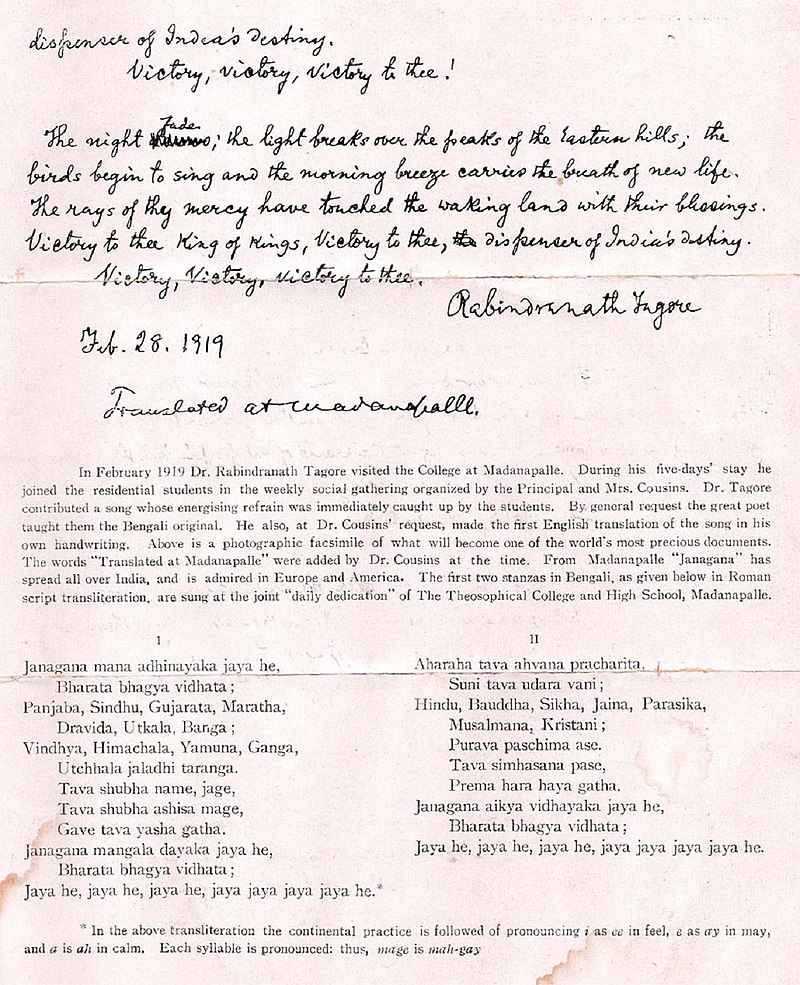Table of Contents
The national anthem of a country is a powerful representation of the culture, history, and ideals of that country and it’s not just a piece of music. The National Anthem of India, “Jana Gana Mana,” is very dear to its people and reflects India’s unity and diversity in a beautiful way.
National Anthem of India
The National Anthem of India ‘Jana Gana Mana’ was composed in Bengali by Rabindra Nath Tagore on 11th December 1911. The original song, ‘Bharoto Bhagyo Bidhata’ is the Brahmo hymn consisting of five verses of which only the first verse has been taken as the National Anthem.
If stated briefly, the National Anthem reflects the spirit of pluralism, or in more common terms, the concept of ‘Unity in Diversity,’ which is vital to India’s cultural history. The original song ‘Jana Gana Mana’ is written in Bengali but in a Sanskritized dialect known as Sadhu Bhasha. You can also check here other National Symbols of India for general awareness.
National Anthem of India Lyrics
The lyrics of the National anthem of India has been provided below:
Jana-gana-mana-adhinayaka, jaya he
Bharata-bhagya-vidhata.
Punjab-Sindh-Gujarat-Maratha
Dravida-Utkala-Banga
Vindhya-Himachala-Yamuna-Ganga
Uchchala-Jaladhi-taranga.
Tava shubha name jage,
Tava shubha asisa mage,
Gahe tava jaya gatha,
Jana-gana-mangala-dayaka jaya he
Bharata-bhagya-vidhata.
Jaya he, jaya he, jaya he, Jaya jaya jaya, jaya he!
National Anthem Original Translation
Check the original translation of the National anthem of India ‘Jana Gana Mana’ below:


History of Indian National Anthem
The National Anthem of India was initially sung on Calcutta’s annual session of the Indian National Congress held in Calcutta on December 27, 1911. Sarala Devi Chowdhurani, Tagore’s niece, along with a group of school students performed the song, in front of leaders of Indian National Congress as Bishan Narayan Dhar, Indian National Congress President and Ambika Charan Majumdar.
The National Anthem of India was published in 1912 with the title of ‘Bharat Bidhata’ in the Tatwabodhini Patrika, which was the official publication of the Brahmo Samaj the editor of which was Tagore. On February 28, 1919, the National Anthem was first sung outside Calcutta, at a session in Besant Theosophical College in Madanapalle, Andhra Pradesh.
The Indian Constituent Assembly met for the first time as a sovereign body on August 14, 1947, at midnight, and the session concluded with a unanimous performance of Jana Gana Mana. Members of the Indian Delegation to the United Nations General Assembly in New York in 1947 performed Jana Gana Mana as the country’s national song. The house orchestra performed the song in front of a crowd of representatives from all over the world.
On January 24, 1950, the Constituent Assembly of India declared Jana Gana Mana to be India’s National Anthem.
Occasions for Playing National Anthem of India
The entire version of the national anthem takes roughly 52 seconds to play, while the shorter version takes approximately 20 seconds. The national anthem is a source of pride for all citizens of the country, and it is mandated to be played at the events stated below:
- President’s address to the nation
- When the National Flag is hoisted
- Before the arrival and departure of the President or Governor from a formal ceremony
- When the Regimental Colors are presented
- During parade demonstrations in front of the dignitaries
The National Anthem is not to be played for the Prime Minister generally, except under special circumstances. When the National Anthem is performed by a Band, a roll of drums is to precede the real performance to alert the audience and prepare them to give respect. The roll will be 7 paces of slow march, beginning gently, gradually increasing in loudness, and being audible until the last beat.
Code of Conduct for National Anthem of India
The Government of India has established a unique set of laws and regulations to monitor the proper and correct delivery of the National Anthem. The Prevention of Insults to National Honour Act, 1971, was enacted by the Government of India to prohibit any intentional disrespect or insult to the country’s National Anthem. Individuals who violate the code of conduct will be imprisoned for at least 3 years as well as monetary fines. The code of conduct for the National Anthem of India is as follows:
- First one should stand up in attention.
- Second, the head of the individual should be held high.
- The third one should always look forward.
- Mass singing of the National Anthem of India is to accompany the unfurling of the National Flag.
- Distortion of words or music of the National Anthem is not allowed.
Significance of National Anthem of India
One of the strongest assertions of a nation’s independence is found in its national anthem. There are many different languages and dialects in India. Since ‘Jana Gana Mana’ is universally known in India, it promotes a sense of togetherness among these various languages.
The traditions and principles that still serve as the foundation of our nation are beautifully captured in the words of our national anthem. It supports the idea that Indian culture is tolerant and integrating and that plurality is tolerated. By solemnly chanting the hymn-like words, Jana Gana Mana evokes the nation’s patriotic feelings and aids in bringing together the many races, castes, and religious groups.


 Daily Quiz 16 April 2025
Daily Quiz 16 April 2025
 Bhashanet Portal : Empowering Multilingu...
Bhashanet Portal : Empowering Multilingu...
 Soyuz Aircraft: History, Design and Sign...
Soyuz Aircraft: History, Design and Sign...





















